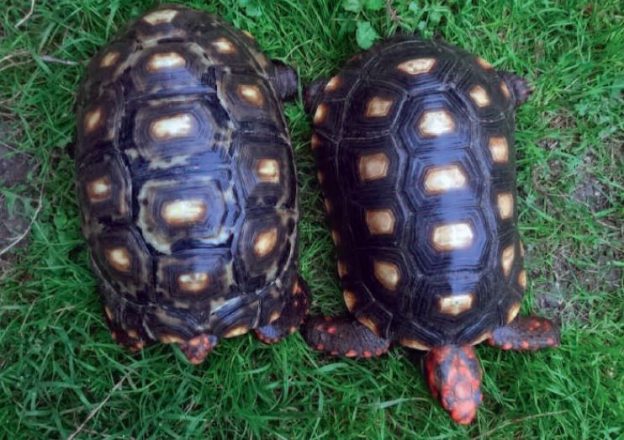
The Red-Footed Tortoise (Geochelone carbonaria) is one of the most beautiful species of tortoise. It is widespread in South America and, reflecting its wide distribution, there are numerous different local variants. These differ in details of their coloration and their potential eventual size.
The latter is especially important when keeping the species in temperate zones where climatic conditions make year-round outdoor maintenance impossible. And large specimens require a lot of space. The largest Red-Footed Tortoise known to date had a carapace length of 59 cm! However, the individuals imported from the Guianas by reptilia24 don’t grow anything like as large and are full-grown at on average just 30-35 cm long, with a single exception attaining 40 cm. Males grow larger than females. Red-Footed Tortoises have been artificially introduced to several Caribbean islands by humans, and although different climatic conditions prevail there, Red-Footed Tortoises have proved to be very adaptable; they are very resistant to stress, and very readily get used to humans, becoming extremely tame! This makes them ideal and very attractive pets. Despite their enormous distribution, populations of the Red-Footed Tortoise are declining, at least locally. As ever environmental destruction is the number one threat, but the use of these tortoises as food – not only in South America, but also in China! – is also causing their populations to contract. By contrast, the international trade in live specimens for captive maintenance is well-regulated by the Washington Convention (CITES) and appears to be having no noteworthy effect on population levels. It is nevertheless important that we develop techniques for successful breeding, as on the one hand it is possible that an export ban may be imposed and then we will be reliant on captive bred stocks, and on the other hand exports are taking place from just a tiny area relative to the overall distribution region. It may well come to pass very rapidly that a conservation breeding program proves necessary as the only way to save specific populations from extinction. By then it will be too late to experiment, we must already have tried and tested techniques in place for breeding these lovely tortoises. In their general criticism of the pet trade and pet owners, so-called “animal pro tectio nists” repeatedly overlook the fact that practically all our knowledge regar ding the details of the biology of small animals derives from private animal owners! I will detail below the essential prerequisites for the successful breeding of the Red- Footed Tortoise in captivity in temperate climates.
Accommodation
The official advice on the minimum requirements for the maintenance of reptiles recommends a bottom area of 8 x 4 times the length of the plastron (lower shell) of the Red-Footed Tortoise as the minimum size for optimal long-term maintenance. This recommendation may not be law, but is almost always cited in court cases regarding animal maintenance. On this basis a 40 cm long Red-Footed Tortoise requires a terrarium with a bottom area of 320 x 160 cm in the long term; the height is immaterial. I initially kept my tortoises in a terrarium, then in a room specially converted for them, but I would recommend first trying the method I use now, namely maintenance in a heated greenhouse, as being the most satisfactory for all concerned. My greenhouse has a floor area of 21 m2 (7 x 3 m) with an adjoining outdoor area measuring around 60 m2. The greenhouse has 16-mm triple-glazing. The front is 15 mm insulated glass for better observation of the tortoises. The heating consists of two radiators and underfloor heating, connected to the oil-fired central heating in my house. The special heating pipe from the house is insulated by being buried 80 cm deep in the ground. This system permits the permanent high temperatures required to be achieved. An automatic shower system serves to simulate showers of rain. Some individuals enjoy a shower on hot days while others come out only after the rain. Several plant tubs and a large wooden box provide the tortoises with somewhere to rest and hide. The floor consists of bark mulch and sand. A large heap of a peat-sand-humus mixture was created to serve as a place to lay eggs. The outside enclosure is planted with grass, meadow weeds, and a few bushes. The temperature at night is around 25 °C and up to 45 °C during the day. Automatic ventilators and the door allow the high temperature to drop to around 35 °C in the middle. This comes very close to natural conditions (Vinke & Vinke, 2000). The tortoises are inactive when it is hotter in the greenhouse. Their main period of activity is in the morning and afternoon, when they like to go looking for food or proceed to mate.
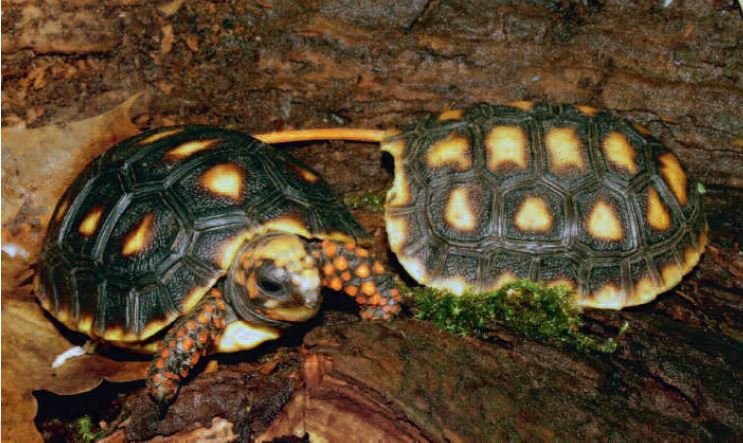
Red-Footed Tortoises in the Guianas
In the Guianas the Red-Footed Tortoise lives on dry tropical savannahs bordering rainforest areas. According to Thomas and Sabine Vinke (2000), the vegetation in these biotopes consists mainly of sedges (Cyperus and related genera); in elevated areas there are creepers and low scrub which the tortoises like to use as cover during the night and/or the noon-day heat. There are only temporary bodies of water (e.g. rain puddles) where the tortoises can regulate their water budget. Only a few specimens of Geochelone carbonaria are to be found in the adjacent rainforest. There are no marked seasonal fluctuations in the climate. The temperature during the day lies between 26 and 36 °C and at night between 25 and 29 °C. The humidity is permanently high, measuring between 80 and 100%. In the wild these tortoises rest when it is very hot. They are active early in the morning and in the evening, which accords with my obser – vations during greenhouse maintenance.
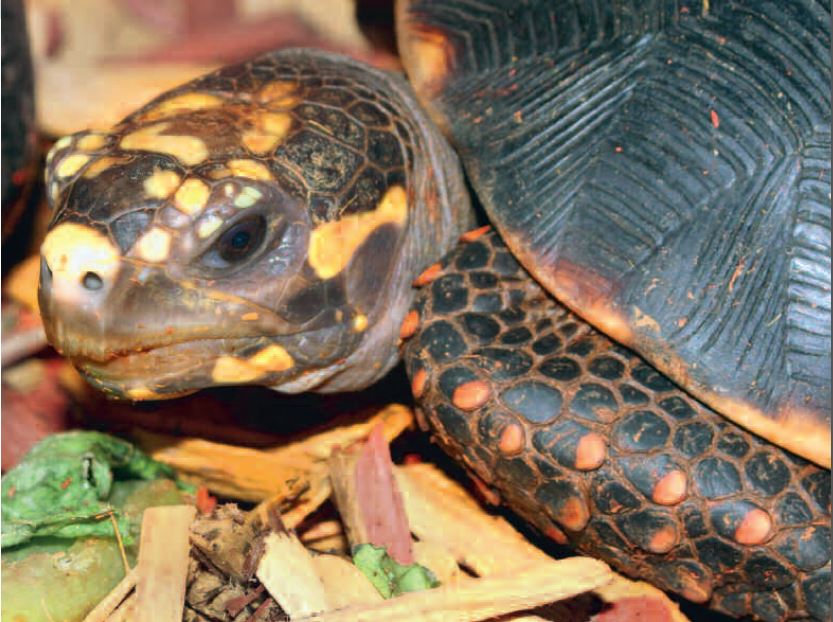
Always important: the correct food!
The accommodation for these tortoises is certainly an important factor, but many different roads lead to Rome in this respect. Ingenious terrarium keepers will undoubtedly be able to create optimal conditions for these tortoises without using a greenhouse, and a well-designed terrarium is also suitable for the maintenance and breeding of Red-Footed Tortoises. The really decisive element in successful breeding is the correct feeding of the tortoises!
During the months of April to October I feed mainly wild plants such as dandelions, narrow- and broad-leaved plantains, clover, thistles, stinging nettles, lesser bindweed, and grasses. Depending on the season my tortoises also receive assorted home-grown salad greens, cabbage, leaves from bushes, zucchini and paprika. In summer and autumn they get a certain amount of windfall fruit as treats, but too much fruit is very bad for the gut flora of the tortoises and often results in diarrhea. Grass plays a special role in the feeding of Red-Footed Tortoises. It contains a lot of fiber and is greatly enjoyed by my tortoises. Many owners report, however, that their Red-Footed Tortoises Gras won’t eat grass. In my opinion this reflects a problem with the diet overall, as if the animals become accustomed to too much fruit (there are no fruit trees on the savannahs!) then they will turn their noses up at the grass that more closely simulates their natural diet. In summer my tortoises also get a weekly feed of soaked hay pellets manufactured by Agrobs. In winter they receive this type of food three to four times per week. Interestingly, tortoises that I have taken over from other people will accept hay pellets only after a long settling-in period, while “new” wild-caught specimens eat them immediately. This reflects the natural food supply, which undoubtedly includes a high percentage of grass. Endive leaves, Romaine lettuce, cabbage, finelygrated carrots, and dandelion leaves complete the balanced diet for the cold part of the year. Paprika, mushrooms, or citrus fruits are also fed every three to four times per month during the winter months.
Every four weeks year-round my tortoises receive freshwater fish (Roach or Smelt) or turtle pellets, to provide them with animal protein. This is necessary in the case of Red-Footed Tortoises, unlike in many other tortoise species. They swallow the fishes rapidly, heads, bones, and all.
I completely refrain from the use of synthetic vitamin preparations as I am worried about hypervitaminosis. Cuttle fish bone and crushed hens-egg shells are permanently available so that the tortoises can regulate their own calcium requirement. Females of Geochelone carbonaria have a particular preference for eggshells instead of the cuttlefish bone so beloved of other tortoises.
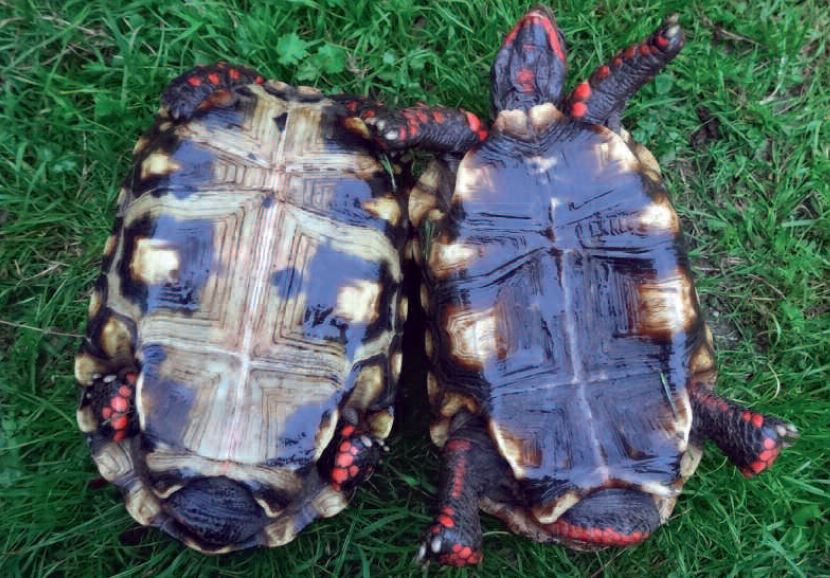
Mating and egg-laying
Mating takes place year-round in Red-Footed Tortoises, but is particularly frequent during the months from May to August when they are living outside. The male approaches the female, moving his head from side to side (head-wagging). The male then mounts, and if the female is ready to mate, she raises her hind legs: the prerequisite for successful copulation. If the female isn’t interested she walks away, feeds, or looks for a place to rest. There is none of the ramming and biting that occurs in European tortoises, for example. Red-Footed Tortoises, even full-grown males, are completely peaceful among themselves.
In the natural habitat the main egg-laying season lies roughly between October and March, but this natural rhythm generally undergoes a shift in captivity. My tortoises lay eggs year-round, but until 2001 with the main focus being during the winter months, as in the wild. As a result of the greenhouse maintenance the incubation period started around eight weeks earlier, and I attribute this to the changed climatic conditions. In the cellar room, where I had previously kept my Red-Footed Tortoises, the roughly 20 cm high heap of bark-mulch/peat/sand mix was well accepted for egg-laying, but ever since the beginning of greenhouse maintenance they have laid eggs either in the heap or outside.
Egg – laying is sometimes preceded by test excavations. A few days beforehand the female becomes fidgety and looks for a suitable spot. Nevertheless it can also happen that a female tortoise proceeds straight from the food dish to egg laying. As a rule the female excavates a shallow, 5- 15 cm deep, pit for egg-laying. Clutch size varies between 3 and 10 eggs, but there are usually 5-6 eggs per clutch. The nest is usually created in the late afternoon or the evening. The procedure takes several hours. The female drinks greedily before and after egg-laying. Once the egg laying is finished I dig up the eggs and transfer them to an incubator.
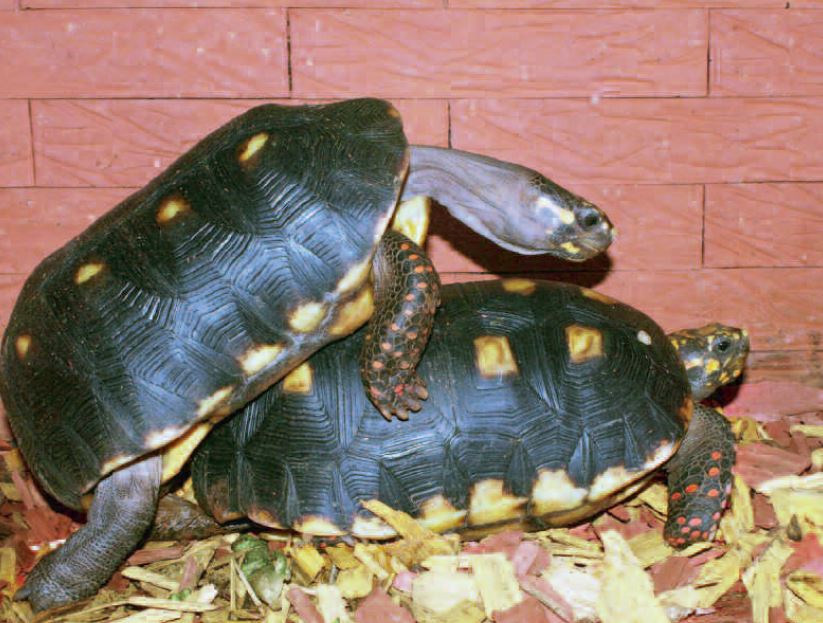
Incubation and hatching
I initially incubated the eggs in vermiculite at a constant 29 °C and almost 100% humidity, but not a single egg developed under these conditions! Subsequently all eggs have been buried in a plastic bowl filled with a slightly damp humus/ peat/sand mixture, which is then covered with moss. The earth-filled plastic bowl is then placed in a larger plastic bowl full of water, which is heated to 28-33 °C using a heater-stat. The plastic bowl is up to 3?4 covered and stands in the tortoises’ living quarters. From around the 115th day on the substrate is kept somewhat damper.
Hatching is announced by splits in the eggs, with the young Red-Footed Tortoises emerging after 120-145 days. Some of them still have quite a large yolk sac and remain in the egg for a few more days until it is completely consumed. Some youngsters die for no obvious reason shortly after hatching. This phenomenon is known to other breeders as well and is widespread, with the majority of owners attributing it to incorrect Incubation methods.
In my case the hatch-rate didn’t improve until I changed the feeding and added hay pellets. In my opinion the hatchability of the eggs depends very heavily on the health of the parent tortoises, which in turn is greatly influenced by the feeding regime and maintenance conditions. In my case the number of dead young decreased drastically after I changed the feeding regime. In addition periodic separation of the sexes during the egg-laying season also appears to have a positive effect, but further study of this is required.
Red-Footed Tortoises are generally productive. In the space of somewhat more than three years I have had 71 young hatch from four females. Both males and females hatched at the chosen temperature.
In conclusion I would like to say that the Red-Footed Tortoise is not only a splendid pet but also readily breedable. The decisive factor, and one that is often completely underestimated, is the correct feeding of the mother tortoise.
If you are now filled with the desire to keep Red-Footed Tortoises, your pet dealer can undoubtedly order some for you from a reliable wholesaler such as www.reptilia24.com.
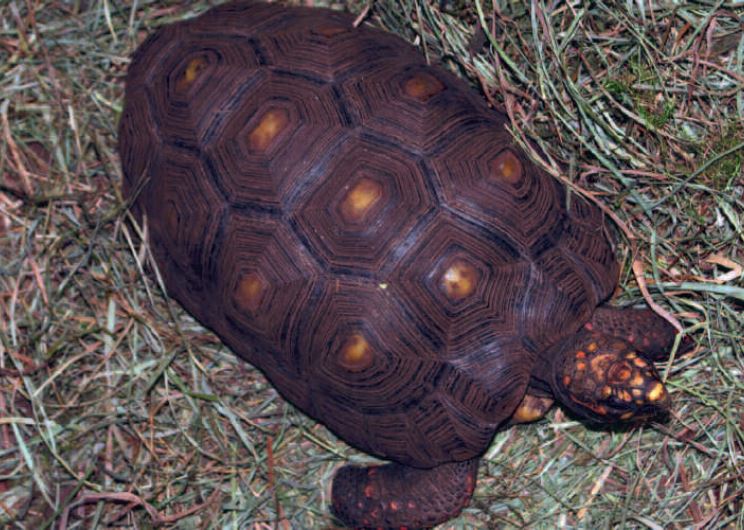
Anzeige






